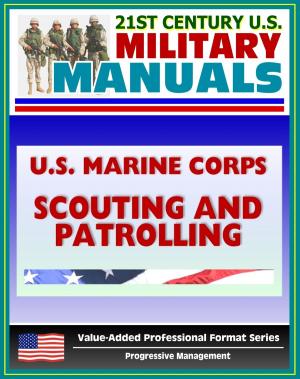Condensed Analysis of the Ninth Air Force in the European Theater of Operations of World War II: D-Day, Normandy, Ardennes, Battle of the Bulge, Middle Wallop, Biggin Hill, Second World War
Nonfiction, History, Military, World War II| Author: | Progressive Management | ISBN: | 9781311370044 |
| Publisher: | Progressive Management | Publication: | November 14, 2014 |
| Imprint: | Smashwords Edition | Language: | English |
| Author: | Progressive Management |
| ISBN: | 9781311370044 |
| Publisher: | Progressive Management |
| Publication: | November 14, 2014 |
| Imprint: | Smashwords Edition |
| Language: | English |
The original edition of this work was published as a Special Study — RESTRICTED — by Headquarters, Army Air Forces, Office of the Assistant Chief of Air Staff, Washington, D.C., in March 1946. The study was approved by Headquarters, United States Air Forces in Europe and Headquarters, Army Air Forces. All the information in the original edition, including the title and subtitle, appears in its entirety in this reprint. It is titled as an analytical study of the operating procedures and functional organization of tactical air power as developed by the Ninth Air Force in the war of Western Europe.
The Condensed Analysis contains a short history of the Ninth Air Force in World War II, from the build-up before the invasion of the European continent through subsequent combat operations in 1944 and 1945. More than a narrative history, the study examines the problems that Ninth experienced in conducting joint combat operations with ground forces across the rapidly moving battlefront in France and Germany. Some of its recommendations were implemented after World War II, others involve issues we continue to struggle with today: The need for a theater level air headquarters, command and control of tactical air forces, the importance of air-ground cooperation (including the co-location of headquarters), and the absence of the capability to mount night and all-weather operations—the lack of a "real and effective 24-hour-a-day operation." In its comprehensiveness, the Condensed Analysis also touches aircrew training and rotation, air base defense organization, civil engineering support, intelligence—virtually every one of today's Air Force specialties.
Since 1945 the Air Force has gone far in creating a modernized force structure with highly professional personnel. Yet many of the doctrinal problems identified during World War II are still with us today. A look back, therefore, can be a useful reminder of how such problems developed and how they might be solved.
Chapter I - Introduction * Chapter II - A Critical Review of Ninth Air Force Operations * A. General Operational Considerations * B. Pre-Invasion Tactical Air Offensive. (16 October 19435 June 1944) * C. Campaign of Normandy. (6 June 1944-24July 1944) * D. Campaign of Western France and Brittany. (25 July 1944-25 August 1944) * E. Campaign of Eastern France and the Siegfried Line. (26 August 1944-15 December 1944) * F. Campaign of the Ardennes. (16 December 1944-28 January 1945) * G. Campaign West of the Rhine River. (29 January 194524 March 1945) * H. Campaign of Central Germany, Austria, and Czechoslovakia. (25 March 1945-7 May 1945) . * I. Maps of Above Campaigns * Chapter III - A Critical Review of Ninth Air Force Organization * A. Organization and Build-Up * B. Organization of Commands: * 1. IX Fighter Command * 2. IX Tactical Air Command * 3. XIX Tactical Air Command * 4. XXIX Tactical Air Command * 5. XII Tactical Air Command * 6. 9th Bombardment Division * 7. IX Troop Carrier Command * 8. IX Air Defense Command * 9. IX Engineer Command * 10. IX Air Force Service Command * C. Summary of Organization * D. Charts: * 1. Organization of the Ninth Air Force as of 8 December 1943 * 2. Organization of the Ninth Air Force as of 29 February 1944 * 3. Organization of the Ninth Air Force as of 9 June 1944 * 4. Organization of the Ninth Air Force as of 24 November 1944 * 5. Organization of the Ninth Air Force as of 8 May 1945 * Chapter IV - Conclusions and Recommendations: External * (Derived from an analysis of Ninth Air Force relationships with lateral and higher headquarters of the ground and air forces). * A. General
The original edition of this work was published as a Special Study — RESTRICTED — by Headquarters, Army Air Forces, Office of the Assistant Chief of Air Staff, Washington, D.C., in March 1946. The study was approved by Headquarters, United States Air Forces in Europe and Headquarters, Army Air Forces. All the information in the original edition, including the title and subtitle, appears in its entirety in this reprint. It is titled as an analytical study of the operating procedures and functional organization of tactical air power as developed by the Ninth Air Force in the war of Western Europe.
The Condensed Analysis contains a short history of the Ninth Air Force in World War II, from the build-up before the invasion of the European continent through subsequent combat operations in 1944 and 1945. More than a narrative history, the study examines the problems that Ninth experienced in conducting joint combat operations with ground forces across the rapidly moving battlefront in France and Germany. Some of its recommendations were implemented after World War II, others involve issues we continue to struggle with today: The need for a theater level air headquarters, command and control of tactical air forces, the importance of air-ground cooperation (including the co-location of headquarters), and the absence of the capability to mount night and all-weather operations—the lack of a "real and effective 24-hour-a-day operation." In its comprehensiveness, the Condensed Analysis also touches aircrew training and rotation, air base defense organization, civil engineering support, intelligence—virtually every one of today's Air Force specialties.
Since 1945 the Air Force has gone far in creating a modernized force structure with highly professional personnel. Yet many of the doctrinal problems identified during World War II are still with us today. A look back, therefore, can be a useful reminder of how such problems developed and how they might be solved.
Chapter I - Introduction * Chapter II - A Critical Review of Ninth Air Force Operations * A. General Operational Considerations * B. Pre-Invasion Tactical Air Offensive. (16 October 19435 June 1944) * C. Campaign of Normandy. (6 June 1944-24July 1944) * D. Campaign of Western France and Brittany. (25 July 1944-25 August 1944) * E. Campaign of Eastern France and the Siegfried Line. (26 August 1944-15 December 1944) * F. Campaign of the Ardennes. (16 December 1944-28 January 1945) * G. Campaign West of the Rhine River. (29 January 194524 March 1945) * H. Campaign of Central Germany, Austria, and Czechoslovakia. (25 March 1945-7 May 1945) . * I. Maps of Above Campaigns * Chapter III - A Critical Review of Ninth Air Force Organization * A. Organization and Build-Up * B. Organization of Commands: * 1. IX Fighter Command * 2. IX Tactical Air Command * 3. XIX Tactical Air Command * 4. XXIX Tactical Air Command * 5. XII Tactical Air Command * 6. 9th Bombardment Division * 7. IX Troop Carrier Command * 8. IX Air Defense Command * 9. IX Engineer Command * 10. IX Air Force Service Command * C. Summary of Organization * D. Charts: * 1. Organization of the Ninth Air Force as of 8 December 1943 * 2. Organization of the Ninth Air Force as of 29 February 1944 * 3. Organization of the Ninth Air Force as of 9 June 1944 * 4. Organization of the Ninth Air Force as of 24 November 1944 * 5. Organization of the Ninth Air Force as of 8 May 1945 * Chapter IV - Conclusions and Recommendations: External * (Derived from an analysis of Ninth Air Force relationships with lateral and higher headquarters of the ground and air forces). * A. General















